Closer the Distance review
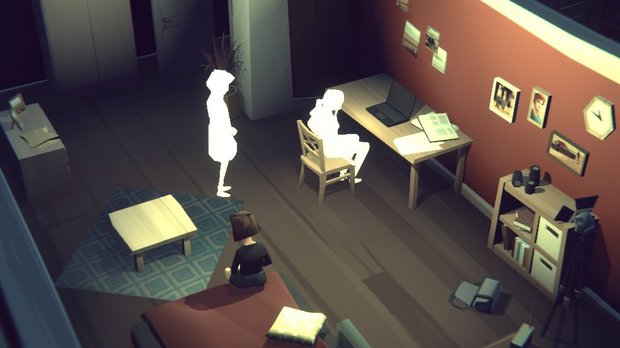
- 0 Comments
This authentic exploration of grief keeps player control at an arm’s length but still hits you in the feels
Unexpected death makes for a popular premise in adventure games. There’s nothing so satisfying as playing detective and solving a murder. Closer the Distance is a completely different game, however, making the emotions of those still alive its primary focus. You’re immediately informed of the sad fate of young Angela, but there’s no mystery surrounding her demise, no conspiracy to uncover, no killer to catch. Instead, Osmotic Studios, creators of the Orwell games franchise, forces you to confront the aftermath of her passing. The thirteen grieving residents of Yesterby, the small community where Angela lived, are in dire need of some guidance “from above.” Not only to come to terms with her passing, but also to deal with their personal needs and desires, to heal the damage to their relationships, and to restore peace and harmony to their town. Helping them do that is so successfully translated into gameplay that I even worried about these characters when I wasn’t sitting behind my computer.
The detail brought to Yesterby was the first element to astound me. This secluded town, drenched in autumnally golden brown color tones, was erected by local entrepreneur Jasper, who bought all the land, built all the houses, then invited people to come live there. There’s a sheep pasture, a cemetery and church, a lookout point with a bench, a campfire near the beach, and a small playground. There’s almost always soft music playing, centering on a singer-songwriter’s mellow folky guitar pieces, except when someone turns on the television. Seagulls fly about, clouds drift by. Sometimes it’s sunny, sometimes it rains. The patter of rain sounds different depending on where you are, outside or inside, and what type of roof is over your head. Each house has its own style and characteristics befitting one of the five families living there.
Angela’s home, where she lived with her sister Conny and their parents Axel and Pia, is very cozy and family-oriented. Jasper’s three-story estate, where he lives with his wife Blanche and their kids River and Eli, is far more luxurious, emphasising functionality over warmth. The town’s doctor Galya asked her girlfriend Leigh and her son Bodhi to move in with her three years ago, so they are still relatively new in town. They have their own greenhouse, since Galya is all about healthy food. Angela’s boyfriend Zek lives with his carpenter father Melville, after his mother died in a construction accident a while back. Melville has a separate workshop where he whiles away the lonely evenings. And lastly there’s old lady Henrietta, living all by herself in little more than a shack in Yesterby’s outskirts, feeling a bit obsolete and never really playing much of a role in this story. During the course of the game, this cast is eventually joined by traveling musician Laul in his motorhome on the main parking lot. The portraits of all characters are lined up at the bottom of the screen, and you can freely check what everybody is up to at all times by clicking on them.

I only dabbled a little in the first version of The Sims back in the day, just copying my own house as every nerd probably did, but I never had the patience for that game. Closer the Distance looks very similar, but with a more stylized, angular aesthetic reminiscent of a more detailed Kentucky Route Zero. The game doesn’t simply offer a static isometric view of the town; instead it lets you freely move the camera around, not only sideways but also completely rotating around the active character. The walls of a house will become transparent when required to focus on the people within. The camera will try its best to automatically give the best view of them. I say “try” because switching characters simply moves the camera to the new person very quickly but retains the same angle, so you might find yourself suddenly staring at a blank wall at the back of a house for a moment until the camera slowly adjusts itself. Even then, a manual correction is often still needed.
Technically speaking, you play as the spirit of the deceased Angela, but you don’t see her on-screen as you would a regular main character, except sometimes as a white silhouette in flashback scenes spread throughout the game, or when some residents “talk” to their memory of her. You do hear Angela’s voice as she comments on major developments, such as when the police come to inform her family about her accident, during her own funeral service, and when she talks to her younger sister Conny, who is somehow able to hear her. Put that down to a mystical sibling connection, I guess.
Conny is the first inhabitant in town you can “influence.” You don’t exactly control them (though I will refer to it that way for the sake of simplicity), but you can offer suggestions as to their daily activities. Each character has an individual agenda, daily routines, and most importantly their own state of mind. The goal of Closer the Distance might seem to be to fully rid everyone of all negative feelings like anger, sadness, woe, aimlessness, guilt, and lots of others. In reality, however, just like in real life, things aren’t that easy. No matter how hard you try, soon you will realize that achieving total bliss for them is impossible, with their emotions constantly running rampant, and choices made for good might even have the opposite effect simply because they have different personalities and thus react in ways you might not expect.
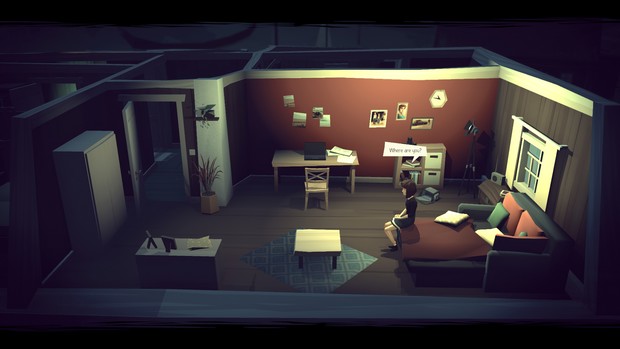
Just as life goes on after a great tragedy, so does time continue to pass by in Yesterby. There’s a day/night cycle and a 24-hour in-game clock advancing in 15-minute intervals, and thus limited opportunities to make people do certain tasks. After all, you can’t interact with characters that have already gone to bed. There’s no manual save system; the game always saves on exit instead, and you can continue exactly where you left off when you come back, even in the middle of a dialogue. The story takes place over a fortnight, but you have the option to reset the active day and start over from that morning, in case you fail a task you would like another shot at it without having to start a new game from scratch (there are three “profile” save slots if you do want to restart completely). Some tasks span several days, though, like a major construction project that’s a key element in the story, and starting over from the last day alone might not be enough to make a difference if you happen to lag behind too much.
Each character has their own personal rhythm and preferences you need to take into consideration when assigning them their tasks. Next to basic needs such as sleep and food, everyone has individual stats you have to try to keep in the green, or at least out of the red. In practice, you’ll have many of the more important and emotional stats hovering in the middle blue, and a hard time keeping them there. Conny, for instance, values solitude and routine, while Galya puts her health above everything. These stats – and all other character information – are visible on the left side of the screen. Click on them and you will see a couple of options on an overview map of the town regarding activities the character can engage in. The basic gameplay consists of this sort of time and stat management.
If you don’t succeed in keeping the characters’ stats up, their emotions will get the better of them and some tasks and activities on the map will become grayed out, meaning you can’t choose them. An emotion icon will appear next to their portraits as well, indicating which stat you need to fix first. For instance, Gayla needs to spend more time with Leigh to keep their relationship in healthy condition, but when she’s too agitated and stressed out, you won’t be able to choose those activities until you’ve raised her resilience by doing some reading or watching TV first.
Sometimes characters will be so engrossed in their activities, you can click their stats and task list all you want but all you’ll get is a low buzzing sound, indicating they’re unavailable at the moment, so you can’t assign them anything. Otherwise, they will always do what you tell them to do, if not exactly as you intended.
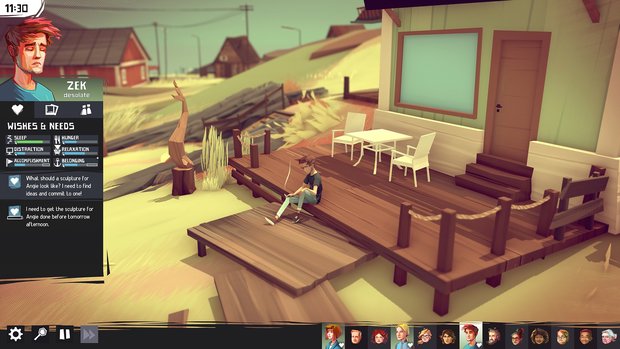
Here’s where I have to admit I had higher expectations for Closer the Distance. The way the game is built up, every few days a new character comes under Angela’s influence. Step by step, you control more people, raising the difficulty of the gameplay by having more lives to manage. I was looking forward to ultimately controlling all fourteen characters by the end, but turns out I was wrong: even at the height of the game, you are still only able to control the same five characters, and as the story nears its conclusion, you’ll once again have to relinquish that control step by step, until Conny is the last one left. Then again, fourteen probably would have been a nightmare to control all at once, and having to influence others indirectly is a very different and intriguing kind of challenge that’s also true to life.
For a while I also hoped that the particular characters you control might be linked to the choices you make early in the game. This would really add to its replayability, after all. But nope, it’s always the same five characters you get to play with: Conny, Zek, River, Galya, and Laul as the outsider who might be able to make a difference since he has a broader view on things (though in practice he doesn’t have that big an influence and seems to be there only to play his guitar and sing a bittersweet song – originally written for this game – whenever a character’s control is severed). New playthroughs can still offer other developments by making alternate choices, however, dividing each character’s time differently, and focussing better on the bigger goals in the game, like Zek’s plans to move out and seek a job in the big city, or River’s construction of a boat lodge to attract tourists.
Throughout the game you’ll constantly have to choose between such character-specific “quests.” For example, Conny can go around and try to console people; at one point she’ll find one of Angela’s old incense sticks, and you’ll need to decide which person she gives it to in an attempt to console them. Galya wants to help out the grieving family, and can either tend to Axel’s sheep, seek someone to help him dig Angela’s grave (though Axel would rather keep busy himself to take his mind off his lost daughter), help Pia with her laundry, or go pick flowers for the wreath, either on her own or with her partner Leigh. Zek commits to making a sculpture for Angela’s grave, but has to decide whether he’ll follow Pia’s wishes, or create something that better fits his own views on who Angela really was. He tends to get a little worked up now and again, though, so he needs to calm down regularly through some form of relaxation. These are only the first couple of tasks to choose from, and the list goes on as you proceed. Every decision you make not only influences people’s personal stats, but also the relationships between the characters, like if Zek is caught smoking by his dad, or if Leigh starts to feel that Galya is neglecting her.
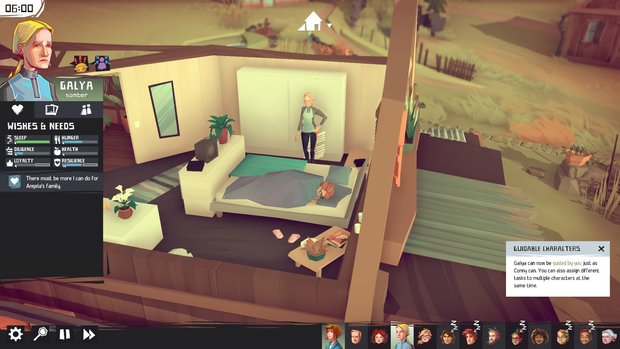
The characters you can’t control also have personal wants and desires. You can try to accommodate them with the characters you can control, by talking to them, doing things for them, or getting them involved in other people’s projects. In the meantime, they have their own tasks they will want to complete as well, which they will go about doing automatically. Since there are only so many hours in the day, you’ll be using the “pause” button more and more to make the most of the available time. Pausing will freeze everything, but you can still check up on all characters, assign tasks to the ones you can influence, then hit “play” again and watch everything unfold. There’s also a “fast-forward” button, which is automatically engaged at night when everyone is asleep. I never saw a need to use it manually during the day, since there’s always something to do or see, though I imagine it would be helpful during replays. When you near the end of the game, though, and the five characters stop being playable one by one, there’s less and less to do. The rhythm slows down instead of rising to a dramatic finale, with one last song from Laul and the end credits fading in. But such an anticlimax truly befits an experience like this, as there’s no final triumphant victory to be found in dealing with grief.
When two or more characters engage in an important conversation, an exclamation mark appears above their portraits and the game pauses automatically (if you’re already following a conversation when a key dialogue occurs, the game will politely let that exchange come to an end before pausing) and waits until you switch to those characters to ensure you don’t miss anything. However, all characters interact with each other throughout the day, and there are lots of optional encounters you can only witness if you keep checking in on everybody yourself.
The game does suffer from an overlap effect, however, when two sets of characters happen to find themselves in the same room when such important conversations occur. They’ll start talking through each other, and it’s very difficult to follow these dialogues. It’s not a one-time occurrence, either; it happened several times in my playthrough, and I’m sure I missed some relevant information that way.
While all this may sound like a lot, Closer the Distance actually plays very organically, and it’s a simple enough user interface to tackle all aspects of gameplay. At first glance I thought it would overwhelm me, but I was quickly impressed by how the writing and programming comes together. This game is a mélange of fourteen separate storylines, with who knows how many varieties depending on the choices you make, which took me over eleven hours to complete in a single playthrough. They’re engaging storylines, too, not bloated with excess filler. These characters feel very real and human, very recognizable. With the help of a good voice cast, of course, but mainly because of the excellent, always believable writing.
Final Verdict
Despite its heavy-sounding subject matter, I was completely charmed by this narrative-focused drama. The idea of a main character influencing the people left behind after her death really speaks to the imagination. Humankind has pondered the mysteries of death for ages; we can fear it or we can embrace it, and this game isn’t afraid to explore grief, loss, and depression without becoming too bleak or overly religious in the process. It’s hard to say a game dealing with these emotions is “fun,” but in some ways it truly is, confronting you with your own helplessness when dealing with others, because you can’t suddenly force people to behave differently simply because you want them to. As a simulation of life, Closer the Distance very much succeeds. Certainly it plays on the feels, becoming a bit dramatic now and again with its artistic cutscenes, trying very hard to make you cry. But overall, this is a narrative that fits in with novels like Reservoir 13, Everything I Never Told You and The Lovely Bones – all dramas about a community dealing with grief and picking up the pieces after a traumatic event. If people still don’t believe video games can be art, they really should play this one!
Hot take
Gameplay is limited to choosing specific tasks to maintain character stats, but Closer the Distance features an intriguing concept of applying indirect influence, and is a beautifully written and very detailed simulation of life in a small community after tragedy has struck.
Pros
- True-to-life simulation of dealing with grief
- Follows the lives of fourteen independent characters simultaneously
- Well-written dialogues make you feel really connected to the cast
- Interesting concept of influencing characters indirectly
- Great voice cast and guitar-based soundtrack
- Different choices and optional content add to replayability
Cons
- Not all fourteen characters are “playable” and it’s always the same five
- Switching between characters can result in weird camera angles
- Key conversations can overlap with multiple characters in the same room
Johnny played Closer the Distance on PC using a review code provided by the game’s publisher.


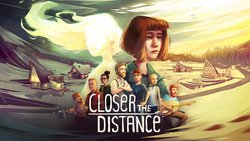
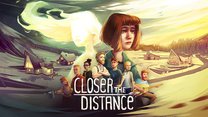







0 Comments
Want to join the discussion? Leave a comment as guest, sign in or register in our forums.
Leave a comment